Here are the step-by-step instructions to create a bell curve (normal distribution graph) in Google Sheets. You may find this chart useful in performance appraisals.
You can find tons of articles online related to the bell curve and its purposes. Here I am just trying to explain how to format your data and plot a bell curve in Google Sheets.
To create a bell curve in Google Sheets we can make use of the normal distribution (gaussian distribution) of the data.
In gaussian distribution, the data near the average are more frequent in occurrence than the data far from the average. If your data falls in this type, the plotted chart will be a bell curve (a bell-shaped curve).
As per the general rule (68–95–99.7 empirical rule) for a standardized normal distribution;
- 68% of the population of the dataset will be within +/- 1 SD of the mean.
- 95% will be within +/- 2 SD of the mean.
- 99.7% will be within +/- 3 SD of the mean.
Note:- SD (‘Std Dev’ also) is the abbreviation of the standard deviation of a sample.
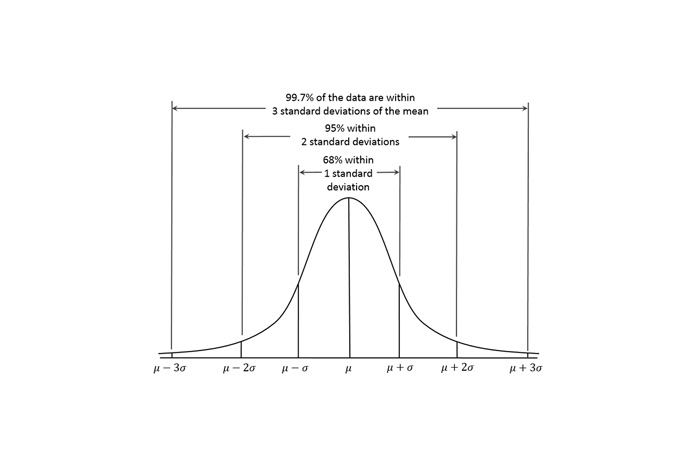
To read the bell curve created in Google Sheets or any other applications, we can refer to this ‘general rule’ chart.
The major part of creating a normal distribution chart aka bell curve chart in Google Sheets lies in the data formatting.
Please follow the step-by-step instructions below.
Sample Data and Formatting for the Bell Curve Chart in Google Sheets
Here is my sample data which is the digital ad revenue for one of my inventory (just sample) for the month of Feb 2019.
The said data is in the column range A1:A28. You can get the sample from the sheet shared just below this image.
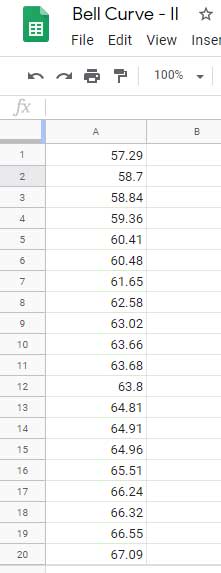
For the data formatting, we can use the functions AVERAGE, STDEV.P or STDEV.S, and NORM.DIST. You will get the formulas below.
Data Formatting for Normal Distribution Chart
Once you have copied the sample data from my shared sheet, you will only need to go through just 5 steps to format the data suitable for the bell curve chart in Google Sheets.
In the below steps 1 and 2, we are going to calculate the mean and standard deviation of the data using the AVERAGE and STDEV.P functions respectively.
Steps 3, 4, and 5 are important as in those steps we are generating the data (normal distribution) to create the bell curve in Google Sheets.
Step 1
Use the following Average formula in cell D1 to return the mean of the earning (ad revenue) for the month of February 2019.
=AVERAGE(A1:A28)Mean: 65.07
Step 2
Use STDEV.P in cell E1 to return the standard deviation of the entire population. If the data is a sample, for example only two weeks of data from February, then use STDEV.S instead.
=STDEV.P(A1:A28)Standard Deviation: 4.26
Step 3
As per the 68–95–99.7 rule mentioned above, 99.7% of the population of the dataset will be within +/- 3 Std Dev of the mean (central peak). 1/2 of the population is < the mean, and 1/2 is > the mean.
So in cells F1 and G1, insert the following formulas to get the probability values further away from the mean.
The formula in F1 to get the value negative to the mean (the result will be 52.28).
=D1-3*E1The formula in G1 to get the value positive to the mean (the result will be 77.86).
=D1+3*E1Step 4
Now generate sequence numbers starting from F1 value to G1 value. Here is an array formula to do that in cell B1.
=sequence(G1-F1+1,1,F1)Simply insert the above formula in the said cell. It will populate the numbers from 52 to 77 in the range B1:B26.
We are one step closer to creating our bell curve in Google Sheets. Before going to that see the screenshot up to this step.
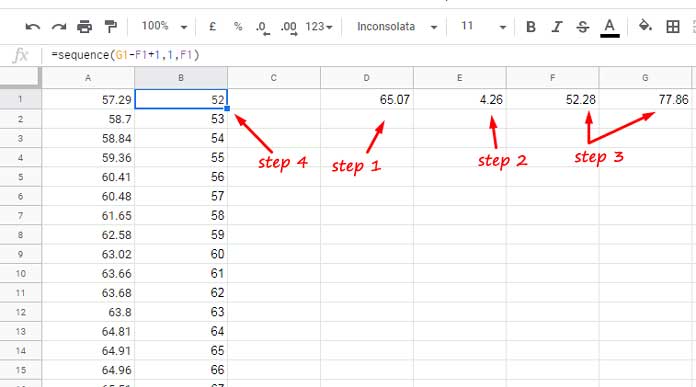
Step 5
Finally, enter the below NORM.DIST normal distribution formula in cell C1 to return the normal distribution of the values in column B. It’s also an array formula.
=ArrayFormula(NORM.DIST(B1:B26,$D$1,$E$1,false))We have just completed our data formatting part. The rest of the part is pretty easy to follow.
Smooth Line Chart for Plotting Bell Curve in Google Sheets
To plot the bell curve in Google Sheets, we must use the Smooth line graph. Here are the steps.
Select the data in B1:C26. Then click on the “Insert” menu to open the drop-down and click on “Chart”. Select the chart type “Smooth line chart” and make a tick (to enable) in front of “Use column B as labels”.
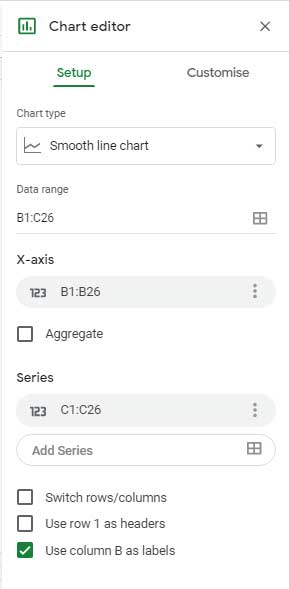
That’s all. We have created a bell curve in Google Sheets.
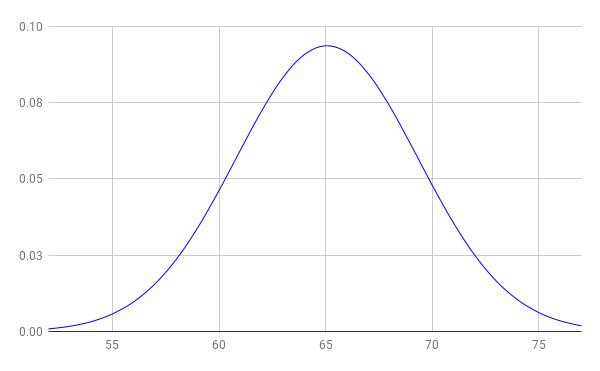
Bell Curve Representation:
- More spread-out bell curve = larger the SD.
- A steep and tall bell curve = smaller the SD.
- In a normal distribution (bell curve), the Mean, Median, and Mode value will be the same.
For more charts please go to the home page of this site or click on the menu “CHARTS” on the top menu bar.
That’s all. Enjoy!




















Thank you so much for showing us this awesome work 🙂
Helped me a lot in my statistics class.
Hi, Leonie,
Thanks for your valuable feedback!